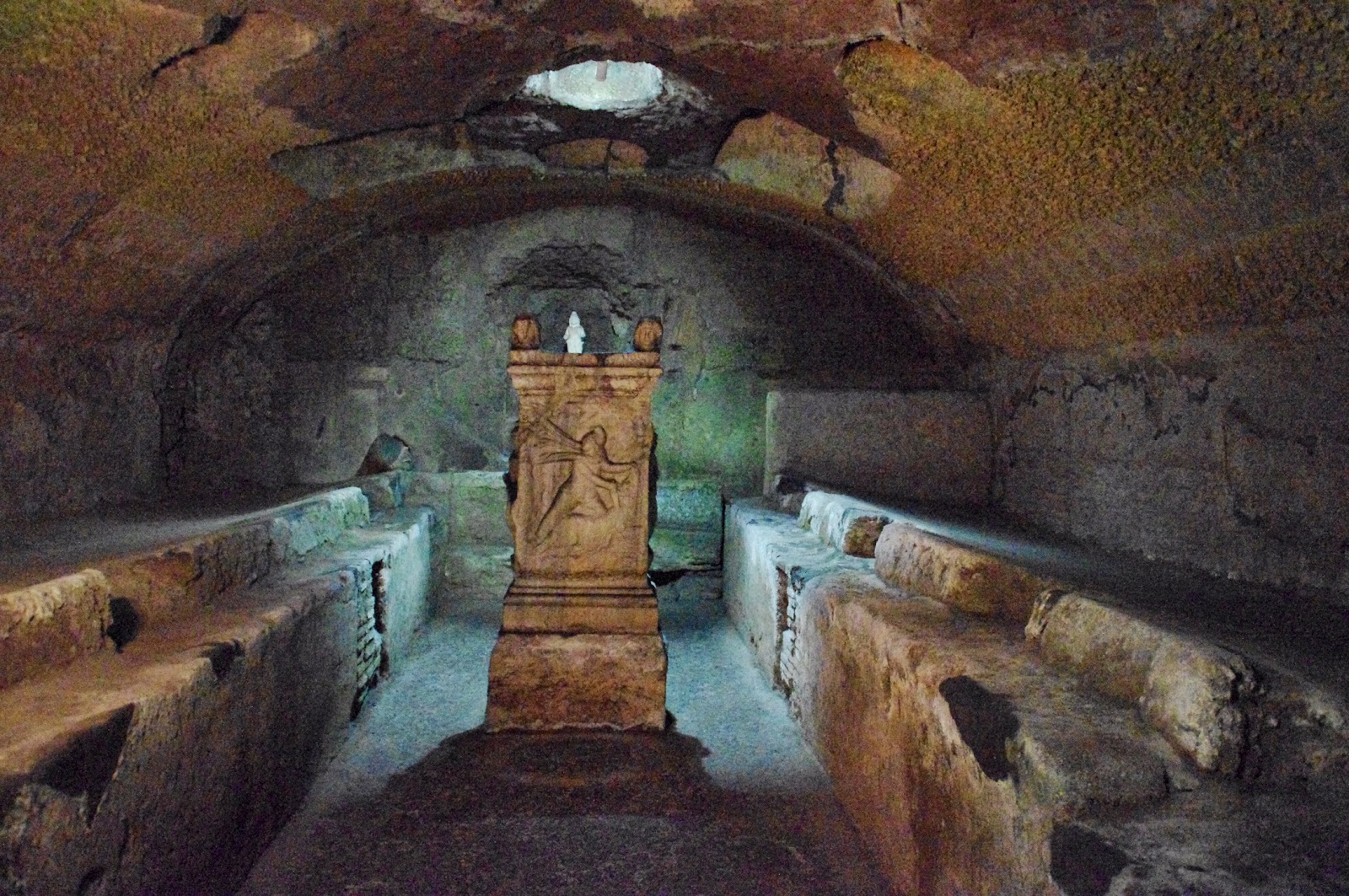Happy May Day! Across Europe, workers are celebrating a day off in their honor--except those in the tourism and food industries. Shops across Rome were closed today, as were many of the usual tourist sites. Happily for our little troop, a tour from City Wonders offered a peek into the underground haunts of Rome's distant deceased citizenry.
We gave Maddie a sleep-in day today, and she used it so well that she almost missed the tour. In the course of her tardiness, though, she learned how to use the Metro by herself, even finding her way in the very confusing and always crowded Termini station.
We met our tour guide at the Tritone Fountain, right across from the shell-shaped drinking fountain where we stopped to fill water bottle yesterday (Rome has the best water!!). At first we were a little concerned as we saw the guide engaged in an argument with her co-worker that seemed pretty contentious. In fact, I initially refused to believe she was our guide. But, she was, and we couldn't have asked for better.
Onto a very nice bus we went, fifteen in all, with Americans (including two girls from California), a nice lady from Scotland, some others of unknown origin/accent, and one sort of creepy guy who spoke his English as though it were not his first language. As we headed to our first stop, St. Domitilla, we drove past the grounds of the Circus Maximus, just over the Palatine Hill from the Forum, where Maddie, Heidi, and I explored in depth on Wednesday. While Amanda the tour guide explained the racing, team alliances, and color schemes in terms of soccer fans, I translated it into my head into NASCAR terms. My Smoke would have made a bitchin' Ben Hur!
St. Domitilla is outside the original city walls, as Romans did not bury their dead in the city and would certainly not allow those new-fangled Christians to be buried there. When Amanda explained to our group just how weird Romans thought Christians were for their habit of "eating their savior" like cannibals, my mind went to Tricia, who still finds it weird 2,000 years later.
St. Domitilla was apparently a fairly wealthy early Christian woman, who donated the land that would bear her church and the catacombs beneath it. The church itself is very plain, but you can clearly see the first century bones beneath a newer structure. The catacombs themselves are nothing at all like those I saw in Paris last year. The miles of tunnels running underneath the church are fashioned into tiny chambers in which little cubbies were dug out to hold the muslin-clad bodies of the dead. For each new Christian, a new cubbie was dug, sometimes just in long rows along the walkways and sometimes in their own little chambers. Nothing was fancy here, except for some third or fourth century frescoes that decorated the chambers of the very wealthy. And the little cubbies, or niches might be a better word, provide evidence of just how small these early Christians were--even Heidi could not fit by height or weight.
The next stop on the tour was San Clemente, what Amanda called an occasion for time travel (the old Scottish lay wondered if we would go into the TARTUS). Here is where you get an idea of just how good those old Romans were at recycling. Why get something new when you can just scavenge from the Forum buildings or other pagan locations? Need a pretty piece of granite for your floor design? Hell, just take it from some other location and make it your own.
The church itself, a basilica, is lovely, with a beautiful mosaic over the apse. But the real treasures were found underneath. According to Amanda, Rome is an historical lasagna. Each generation built on top of the work of those who came before--literally. The current top level contains the 12th century basilica with its lovely mosaic. Go one level down and you find a 4th century basilica. Go one more level down, and you find a typical Roman building that had once been something of an apartment building but even then had been turned into a Mithraic temple. And no one may have ever known had not a 19th century Irish monk living there not been kept awake at night by the sound of running water. Looking for the source (a spring that had broken out of its old Roman water pipe) led this Joseph Mullooly to discover the wonders beneath his church.
The final stop, the Crypt of the Capuchins, was certainly the most bizarre. This is really a museum dedicated to the Capuchin order. Once the Romans were no longer in power, people began to bury their dead inside the city proper. This was common practice by the 15th century, and the Capuchins buried their dead brethren in their church by the Trevi Fountain. When a newer church was built near the Tritone Fountain, they decided to bring these late Capuchins with them. And they turned those dead brothers into the most bizarre art I have ever, or expect ever, to see. The decorations you see in the photos below are made from actual human body parts. The corpses in monk's robes are all just dead Capuchins used as part of the overall macabre motif. Those Parisians and their catacombs look like amateurish losers compared to these interior designers.
I have to admit that none of the photos today were taken by me or Reiner or the girls. This was a no-camera tour, and the people on the tour respected the restriction. There was, however, no written or stated prohibition on touching, and my girls followed by Parisian example by barely touching a bone in passing. Like mother, like daughters.
Tomorrow is a big day, a quick adventure to Venice. Wish me luck!!!











No comments:
Post a Comment